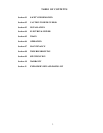
Section 04 ELECTRICAL POWER
4.10 Power Source Review Review the power source and the motor rating to be sure they agree in voltage, phase,
and frequency. Serious damage may occur to the motor if it is connected to an improper voltage. All Welch pumps must be
grounded. Grounding reduces the risk of electric shock in the event of an electrical short circuit. The plug must be plugged
into a properly grounded outlet. Consult your local electrical codes if you have doubts.
4.11 Overload Protection Motor thermal overload protection is made available by the motor manufacturer as anaid
to minimize motor failure.Overload protection is a standard feature on both 50 and 60 Hz single-phase-motors. The motors
have automatic overload protection. Automatic reset protection is designed to reset itself after a predetermined cooling
period. If the fault to the drive remains unaltered, the motor will cycle on and off until the fault is corrected.
4.20 VACUUM CONNECTIONS All pressure/vacuum pumps come with intake and discharge hose barbs which accept
1/4" ID rubber pressure/vacuum hose. Hose clamps should be used to hold the hose in place. Since all three models operate
in the viscous flow regime, the small diameter of the hose will generate minimal conductance loss. For best results, Welch
recommends the length of the tubing between the pump and the chamber be kept as small as possible.
4.21VACUUM AND PRESSURE GAUGES All models of pressure/vacuum pumps come with dial gauges mounted on the
regulator assemblies. The vacuum gauge gives negative pressure - that is pressure below atmospheric. The reference point
for the vacuum gauge is atmospheric pressure.
The pressure gauge gives pressure above atmospheric. The reference point for the pressure gauge is atmospheric pressure.
Please keep in mind that atmospheric pressure tends to vary from day to day. As a result of this variability, the dial vacuum
gauge will indicate slightly different maximum vacuum readings from day to day.
Section 05 TRAPS
5.10 The need for a Trap The pumps will handle humid air. All wetted aluminum parts are treated for corrosion protection
from moisture. All other wetted parts are stainless steel. A plastic trap with a ball check valve is attached to the regulator
assembly to prevent water condensate from accidentally being ingested into the pump. If there is a chance liquid may be
drawn from the process under evacuation, Welch recommends a liquid trap be placed between the process and the pump. A
simple liquid trap is a filtering flask. See figure below.
When a heavy load of water vapor is evolved from the vacuum process, a cold trap is recommended to help prevent damage
to the pump mechanism. The cold trap, immersed in a suitable Dewar flask, is installed so that the water vapors may come in
contact with the surfaces of the trap and condense. Commonly used refrigerants are liquid nitrogen or dry ice and acetone or
alcohol. Dry ice provides sufficient cooling to freeze out most heavy water vapor loads. A variety of cold traps are available
from Welch. Please call our customer service department for additional information at (847) 676-8800.
The pump is not recommended for pumping acid, base or organic vapors or gases. Serious
damage to the pump will shorten the pump’s service life. In addition, pumping flammable
vapors or gases can lead to serious safety hazard leading to fire or explosion.
6














